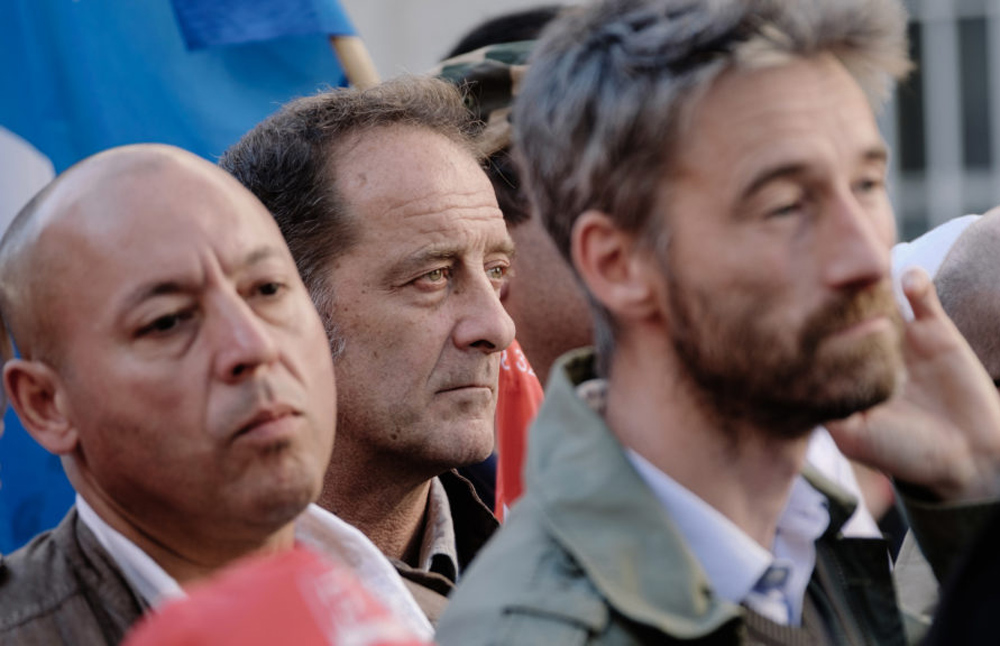Although Stéphane Brizé had done copious research to properly convey the intensity of a workers’ strike in “At War,” it wasn’t until he was standing in front of 250 extras that he was able to get the full feeling of it himself.
“It was the most fun time of my life,” says Brizé, during a recent trip to Los Angeles where the film is opening this weekend. “Honestly, before this film, I [felt] ill when I had more than three actors on the set and suddenly I write a film with 250 workers, completely angry, so before the film, I was afraid, but I was very surprised to see that on the set, it was okay. We had a very short time for shooting the film — 23 days — and I wanted to create a fight energy. Sometimes when I was with my microphone in front of everybody, I [actually] thought I was a union leader [saying], ‘Yes, you must do that! You must do that!’ And everyone would clap.”
Brizé couldn’t bask long in the moment, quickly conferring the role of the labor leader to his longtime leading man Vincent Lindon, whose Laurent Amédéo draws a far more conflicted response as he leads negotiations with Perrin Industrie, an automaker that plans to close one of their plants in in Agen, a company town in Southwest France, and put 1100 workers out of a job. Although Amédéo and his fellow Perrin employees are clear on their end goal, getting the other side to the table is far hazier when the company that was once locally owned and operated is now part of a multinational conglomerate with German headquarters and after they benefitted from incentives contingent on keeping jobs in Agen, there is little jurisdiction to enforce a contract signed just two years prior, leaving the workers little recourse but attempting to publicly shame Perrin with picketing and fight for meetings that appear to accomplish little more than give them the runaround.
The film is Brizé’s second, following his previous collaboration with Lindon, “Measure of a Man,” to draw on the narrative techniques he cultivated in the intimate character studies he made his name on such as 2005’s “Not Here to Be Loved” and 2009’s “Mademoiselle Chambon” while engaging issues of the larger world, often unforgiving and tumultuous in the age of a globalized economy, and the results are often engrossing. As the director takes on his most ambitious film to date, complete with large-scale rallies in the streets and the planning meetings before that often descend into chaos when not everyone is on the same page, you see the burden the workers have to shoulder, most prominently Amédéo, who struggles to keep his brethren in unison over the course of months without pay while scraping for every piece of leverage he can use in the David-versus-Goliath battle. The seemingly mundane details of the negotiations come alive as the dialogue, once open, takes the form of a delicate dance before spilling into Bertrand Blessing’s strident score to give a single, urgent voice to scenes of full-fledged protest.
After premiering last year at Cannes, the timely drama has incited audiences around the world and during a visit to the States, Brizé reflected on his ongoing collaboration with Lindon, the surprises to be found on the set and his turn towards social realist films.
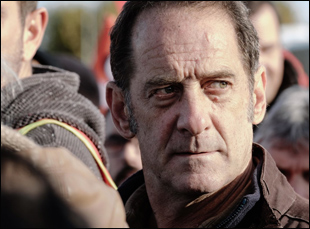
Yes, [there’s] before “Measure of a Man” and after “Measure of a Man.” It is the second part of my life as a director. During a long time I made films only around intimacy – [stories] around the family, around a couple. But for a long time, I wanted to create a link between people and their life [in society]. “Measure of a Man” was the beginning of the possibilities for me to do that, to create the link between a man and the society and it was possible for me to open the window in myself to create this link, and I’m very glad to create this link. For a long time, I was so touched by Ken Loach’s films because since the very beginning of his career, he had created this strong link and all the time he speaks about the problem of how the society transforms men and women. I wanted to do that for a very long time and there are so many things in society which are not normal [now], so it was important for me to start to speak about that with my films.
From a dramatic standpoint, has it been harder to tell compelling stories when the obstacles are so often unseen and only subtly felt?
Yeah, it was most difficult for me because at the end you have a film and you have spectators in front of the screen and before everything, I want to create entertainment. I want people to laugh sometimes – not in this film [laughs], I want them afraid and this material is not very sexy, but I have to transform this into dramaturgy and it’s very interesting because all the time, I ask myself of a normal script, how do I create a surprise for the spectator? At the very beginning, I just listen. I meet people — workers, politicians, HR, directing managers, and of course, lawyers because everything must be true — and I know the story I want to do, but when I meet everybody, it’s so many hours of discussions and then step by step, I have to transform this material to build the story. The media doesn’t really explain or give any kind of backstory to why we have violence in social conflicts. Before the violence there is anger and before anger, there is despair. When suddenly violence appears on the TV, what is the story of this footage? So [this] is the story I wanted to build.
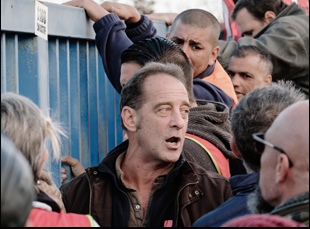
Before writing the film, I knew I wanted this style of music and a few months before I begin to write, I went to see a play [with] acrobats and a musician, a drummer and a guitarist. I didn’t know [Bertrand Blessing, the musician] at all, but I could hear the strong energy of his music, so I went to see him and I told him “I’m going to write a film and your music is the music I want. Can you create the music for me?” He hadn’t created the music for any film before. He only worked for theater, but from the very beginning, I knew it was a big fight during two hours, and I knew that if I tell you you’re going to see a film by Stéphane Brizé, and it begins with this 10-minute [negotiation] scene [where] they speak around the table, then five minutes later, there’s seven minutes [of more talking around a table], then 30 minutes around the table, you say, “No thank you. I have to go to the swimming pool.” [laughs]
But it can be very interesting. I have a scene that’s 17 minutes, the big scene at the end, and on paper, I knew I wanted to do that, but I was afraid. When I was on the set, I thought to myself, “Wow, this is interesting to me, but will it be interesting to the spectator?” But at the end, I think it is very, very interesting because there is a strong dramaturgy in cinema all the time and you must think about everything that’s at play.
Those negotiation scenes are riveting. They look so lively – was there much spontaneity or did it have to be all planned out in advance?
It’s all scripted and it’s impossible to change even small things because it is like the engine of a car. Everything must be at the right place at the right moment because when a worker says something, the directing manager says another thing and because he says that another guy will say another thing, so it’s nine months of writing and after that, I don’t want to change anything. But there are no professional actors, except for Vincent Lindon, and I accept what they say in their own words. I tell them, even Vincent Lindon, “Okay, you must say exactly that, but if you want, tell it with your own words. Of course you can do that because I’m not Shakespeare. I’m not Moliere.” But you can’t say the end at the beginning [or change the order of a scene], so it’s very, very precise. At the end, it’s very important that it looks completely natural and where I put my camera creates that feeling of documentary. It’s not only how they play – that’s very important, but it is how I film that, and the mix creates this feeling. It is a truce.
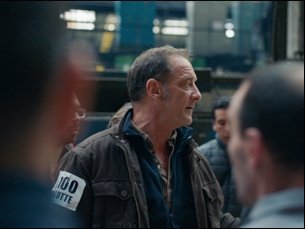
It’s my fourth film with Vincent and it would be impossible to do what we do in this film on our first film. Completely impossible. We are like a couple — it is the best couple of my life with Vincent [laughs] because we speak about everything all the time. When there is something I don’t like in him, I say or the opposite is possible. We speak about everything. And we are very similar. We are [disappointed] for the same things, but when I’m sad, he is very, very sad and when I’m happy, he is very, very happy. Vincent is extreme. Me, I’m in the middle. But it is exactly for the same reasons. I understand him very well. We grew up in very, very different social [conditions] — his parents were very rich. My parents were very simple peasants. But we grew up with the same problem, the intimacy, So at the end, even if you come from very different backgrounds, we are quite the same.
But when I write, I don’t write for Vincent Lindon. I write for myself. The only film I write, even if it is for a woman, [I considering them coming from] the female parts of myself, so I write all the time for me, but suddenly in my life, I met Vincent Lindon and we are very close, so he understands very quickly and immediately what there is in the script and on the set, we don’t speak a lot. The most important thing I can tell Vincent is how to put his body. And film after film, we accept step by step not to know everything. We know the beginning of the scene, we know the end of the scene, but he and I refuse to know the way it will take. I have an idea, but when you shoot, even nonprofessional actors, they know the right way for the scene much more than the director. I know very precisely the beginning of the scene and and it’s very important [to say] “You will follow me only if I say we will go there. Trust me.” After that, we [have a] map and we don’t go the right way maybe sometimes, but we don’t know everything and it’s important not to know everything.
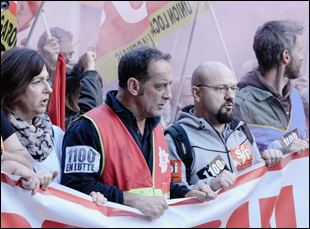
Sometimes it happens. It’s in the second part of the film [when] the workers go to another factory [to protest] and you see them, they enter the factory and say, “Stop! Stop! Stop the machine!” and there is a long discussion between Vincent and the directing manager. The words were in the script, but I’ll tell you how it happened. It was incredible. First, I wanted to shoot another scene, which is [ultimately] not in the film [where] it was with Vincent and some workers, and the workers were saying, “Stop! Strike! Strike!” But I was not very happy with the scene. I watched it behind my screen and at that time, it was the end for Vincent – he walks [around with his shoulders slumped] and at the end of the scene, I didn’t even say stop. It was bullshit for everybody.
I was like [puts face in palms of his hand]. I felt depressed because it was not the writing that was bad or the actors that were bad. It was quite okay. Just not good enough for me. At one moment toward the end of the scene, the [cinematographer] moved with his camera and he started to film the workers in the factory saying, “Strike! Strike! Strike!” [in the background]. And my assistant told me, “Watch, watch, watch” and suddenly I see the truth on my screen. I tell him, “Go near them! Go near them!” And my assistant at that time told all the workers, “Go, go, go, do that here in this area – large like that, and something happened at the time, it was the truth. And I told myself, “Go with the workers and you stop the machine with them.” [snaps fingers] “Go, go, go! Don’t [think about it]” And [Vincent] goes – and it’s what you see in the film.
The directing manager [in the film], who is not an actor, was behind me [at my monitor], and he was waiting for lunch because it was lunch and [afterwards] we had planned to do his scene, but I I knew it was now we had to do it just because the DP moved his camera [to shoot B-roll]. So I told him, “Go and you do the scene we had planned for this afternoon now. You’re right in the middle of the crisis. And you say ‘Stop, stop, stop, stop’ and the discussion [in the scene] will happen.” Vincent didn’t know the directing manager had arrived, and the directing manager said, “I have no microphone!” But the sound engineer heard me and she said to the guy with the microphone, “On him, on him! All the time on him!” And it’s why you can hear it because Vincent had his microphone on. And Vincent, suddenly, sees the [directing manager] arriving and at the first word, he understands what he needs to play and it’s what you see.
And you can’t imagine. Fifteen minutes before, I was so depressed and at that moment, something happened and it was very funny because I was completely shocked by [how the scene wasn’t working] and then [now] for me, the scene is incredible. Everywhere we had real workers and they saw me. It is a miracle. I cried. [laughs] And I thought to myself they must’ve been [thinking] I must be completely on drugs or completely crazy. They see a movie director crying, “It is a miracle. It is a miracle.” So you have to hear the life on the set all the time. You have to create something and then at that moment, the life is stronger.




